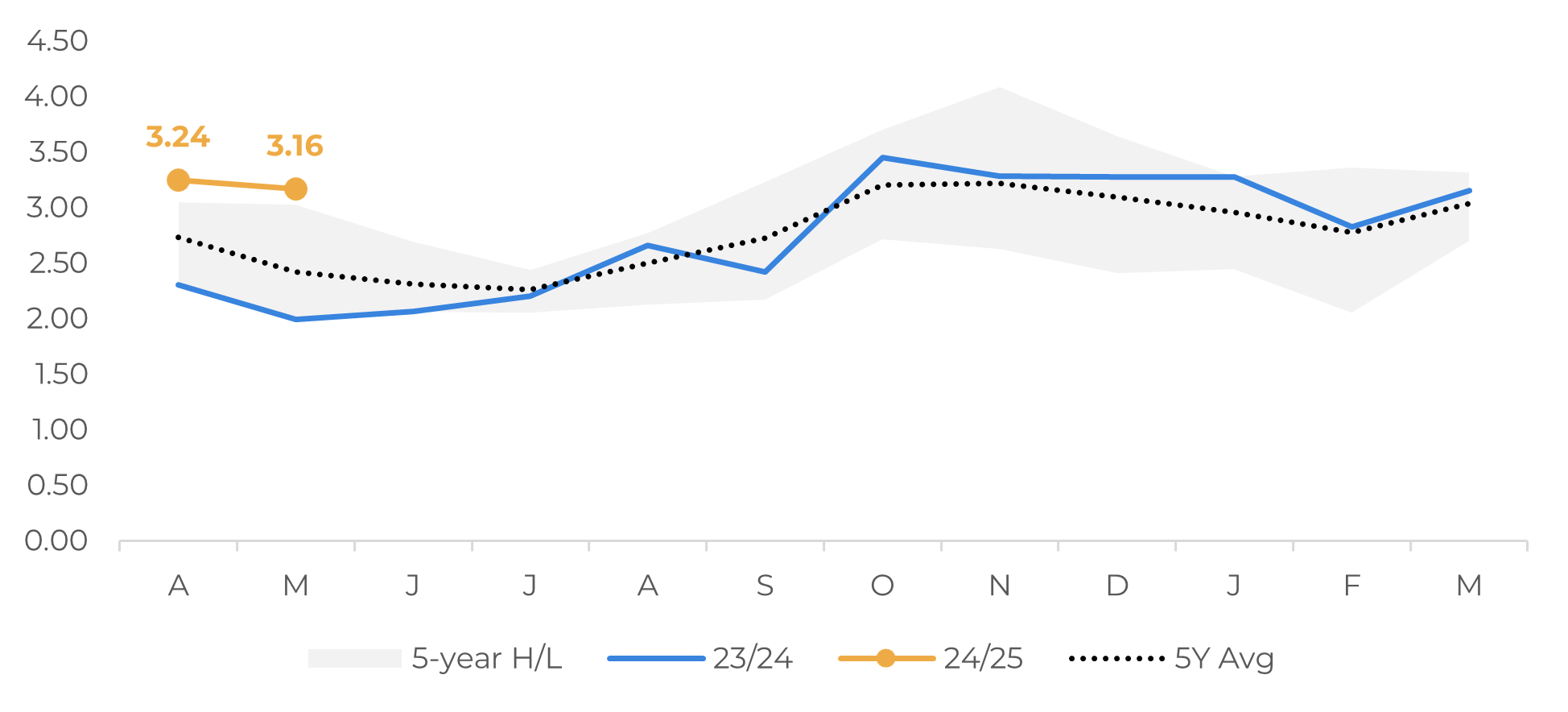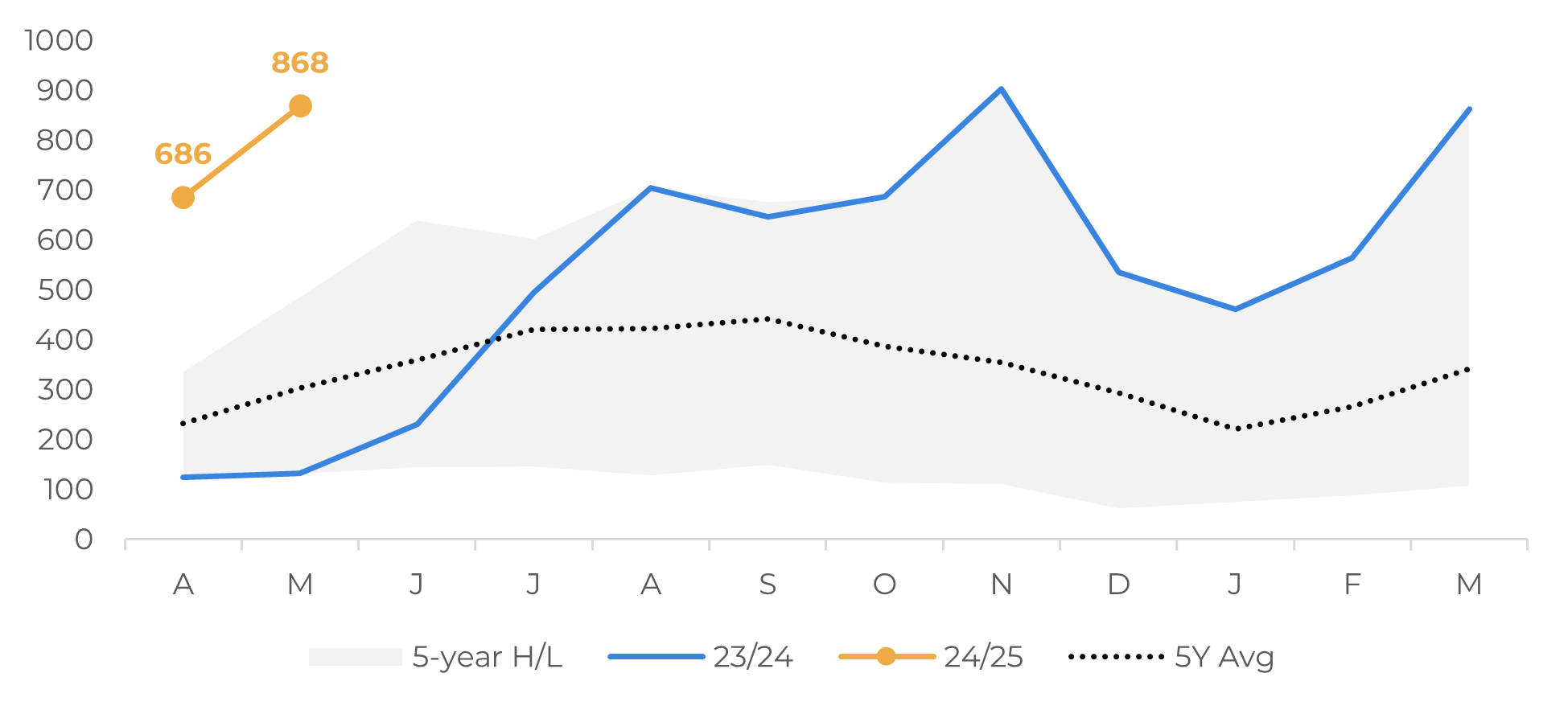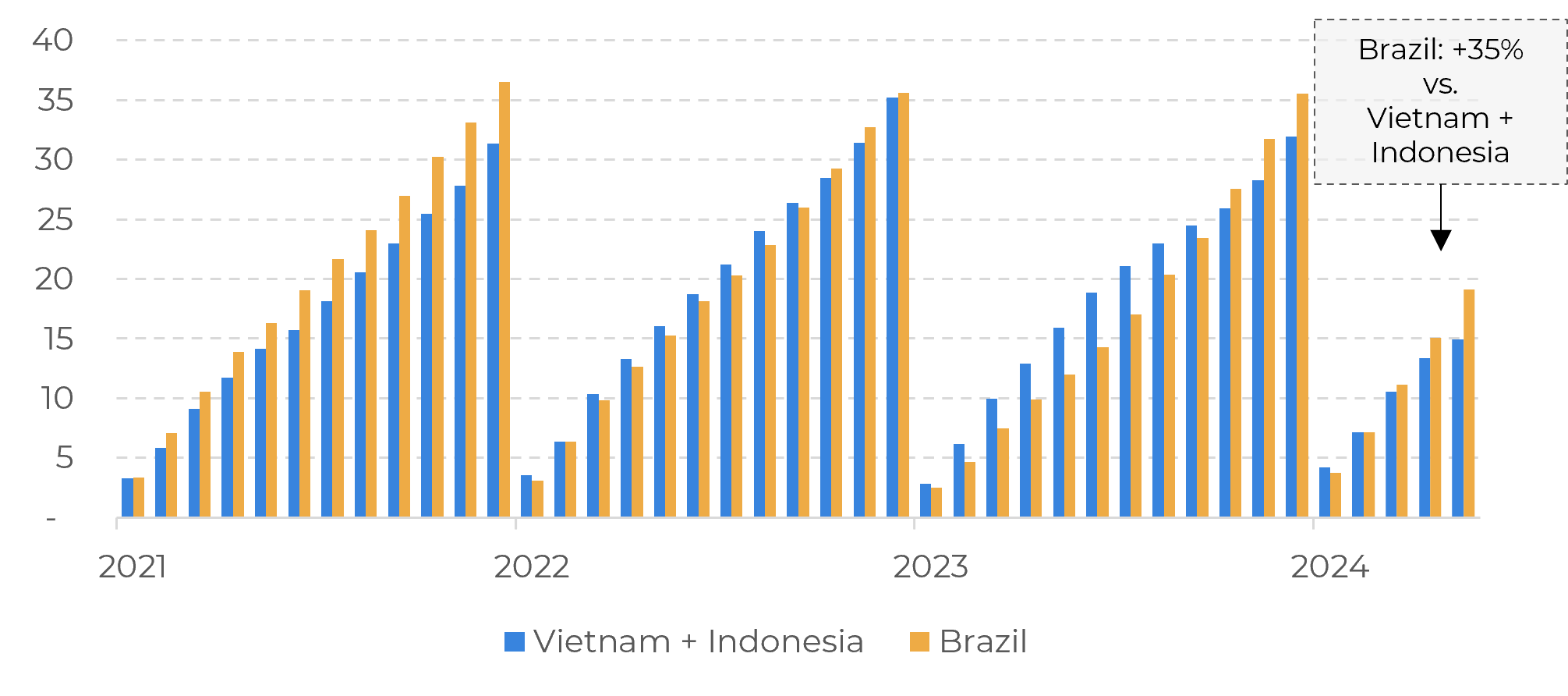
Jun 14
/
Laleska Moda
Coffee Weekly Report - 2024 06 14
Back to main blog page
- Total coffee exports from Brazil continued their growth trend in May, reaching 4.39M bags, up 79.6% year-on-year, according to Cecafe. For green coffee, the growth was 90.2% y/y.
- Arabica exports reached 3.16M bags in May, up 59.1% from last year, and robusta totaled 868K bags, 7 times higher than May/23, following the trend in recent months.
- Total revenue in May was also the highest monthly revenue in Cecafe's entire historical series, at US$ 1.017 billion.
- Meanwhile, Vietnamese exports fell sharply on May, to 1.32M bags of coffee, down 47.8% from April and 47% from a year earlier, reflecting restricted supply in the Asian country.
- On the macroeconomic front, US CPI data and FED decision to scale back rate cuts in 2024, keeping it unchanged at 5.25%-5.50, will influence the commodities market in the next weeks.
Brazilian exports soar in May; Vietnamese, not so much
Cecafe's latest report showed higher export figures in May, confirming the ongoing trend for Brazilian exports. Total shipments (green, R&G, and soluble coffee) last month reached4.39 M bags, an increase of 79.6% compared to 2023, and up 3.2% from April/24.
Green coffee exports edged even higher: +90.2% YoY, at 4.03M bags. Of these, arabica accounted for 3.16M bags, while conilon accounted for 868K bags, 59.1% and 559% (or 7 times) higher than May/23, respectively. Compared to April/24, arabica showed a slight decline of 2.5%, while robusta was up 26.7%. Increased global demand for robusta has been a key factor in the subsequent growth in exports in the past few months.
May shipments were also responsible for generating the highest monthly revenue in Cecafe's entire historical series, at US$ 1.017 billion. The Council highlights that, with just one month to go until the end of the 23/24 commercial season (Jul-Jun), exports are just 2M bags away from breaking the 20/21 crop record (45.7M bags). Export data reinforces Brazil's role as the main coffee supplier globally and its importance on the robusta side, in light of recent declines in Southeast Asia shipments.
Figure 1: Brazilian Exports - Arabica (M bags)

Source: Cecafe
Figure 2: Brazilian Exports - Conilon ('000 bags)

Source: Cecafe
From the end of 2023, we could see Brazil increasing its exports relative to Indonesia and, in particular, Vietnam. In the first five months of 2024, Brazilian shipments are already 35% higher than Indonesian and Vietnamese exports combined.
In regard to the latter, Vietnam’s government data this week showed that the country exported 1.32M bags of coffee in May, down 47.8% from April and 47% from a year earlier. The figure is also well below the historical average for the month (-43.2%). Even with the high export numbers in December and January, the 23/24 Vietnamese shipments (Oct-May) are still 3.3% below 22/23, a trend that may continue next month given lower production.
This scenario has also helped to halt a deeper price correction following the bearish Brazilian data. The market is closely following the 24/25 crop development in Vietnam, as rainfall in 2024 is below historical levels and could affect production.
Finally, on the macroeconomic side, this week's positive CPI data and the FED's decision to keep rates unchanged at 5.25%-5.50% and to scale back to one rate cut in 2024 could have an impact on commodity prices in the coming days, especially regarding the dollar.
Figure 3: Coffee Exports - Brazil x Vietnam and Indonesia (M bags)

Source: Cecafe, Refinitiv, Hedgepoint
Figure 4: Vietnam Exports (M bags)

Source: Refinitiv, Hedgepoint
In Summary
Brazilian exports remain strong in May, particularly for green coffee, already 90% higher than last year. While arabica shipments continue to grow – given the growth in use by roasters after following the narrowing of the arbitrage between NY and LN – conilon is the star of the show!
Lower shipments from Indonesia and Vietnam reinforce the demand for Brazilian beans. In the case of Vietnam, May exports sharply decreased, highlighting restricted availability.
Tight supply in Southeast Asia has helped limit price declines in recent days and may continue to influence the market during the Brazilian harvest, as Vietnam is still experiencing historically low rainfall levels. Conversely, the Federal Reserve's decision to implement just one rate cut this year could negatively affect the commodity market.
Weekly Report — Coffee
Written by Laleska Moda
laleska.moda@hedgepointglobal.com
Reviewed by Natália Gandolphi
natalia.gandolphi@hedgepointglobal.com
natalia.gandolphi@hedgepointglobal.com
www.hedgepointglobal.com
Disclaimer
This document has been prepared by Hedgepoint Global Markets LLC and its affiliates (“HPGM”) solely for informational and instructional purposes, without the purpose of instituting obligations or commitments to third parties, nor is it intended to promote an offer, or solicitation of an offer of sale or purchase relating to any securities, commodities interests or investment products. Hedgepoint Commodities LLC (“HPC”), a wholly owned entity of HPGM, is an Introducing Broker and a registered member of the National Futures Association. The trading of commodities interests such as futures, options, and swaps involves substantial risk of loss and may not be suitable for all investors. Past performance is not necessarily indicative of future results. Customers should rely on their own independent judgement and outside advisors before entering in any transaction that are introduced by the firm. HPGM and its associates expressly disclaim any use of the information contained herein that directly or indirectly result in damages or damages of any kind. In case of questions not resolved by the first instance of customer contact (client.services@hedgepointglobal.com), please contact our internal ombudsman channel (ombudsman@hedgepointglobal.com) or 0800-878- 8408/ouvidoria@hedgepointglobal.com (only for customers in Brazil)
Contact us
hedgepointhub.support@hedgepointglobal.com
ouvidoria@hedgepointglobal.com
Funchal Street, 418, 18º floor - Vila Olímpia São Paulo, SP, Brasil
Check our general terms and important notices.
This page has been prepared by Hedgepoint Schweiz AG and its affiliates (“Hedgepoint”) solely for informational and instructional purposes, without the purpose of instituting obligations or commitments to third parties, nor is it intended to promote an offer, or solicitation of an offer of sale or purchase relating to any securities, commodities interests or investment products. Hedgepoint and its associates expressly disclaim any use of the information contained herein that directly or indirectly result in damages or damages of any kind. Information is obtained from sources which we believe to be reliable, but we do not warrant or guarantee the timeliness or accuracy of this information. The trading of commodities interests such as futures, options, and swaps involves substantial risk of loss and may not be suitable for all investors. You should carefully consider wither such trading is suitable for you in light of your financial condition. Past performance is not necessarily indicative of future results. Customers should rely on their own independent judgement and/or advisors before entering in any transaction.Hedgepoint does not provide legal, tax or accounting advice and you are responsible for seeking any such advice separately.Hedgepoint Schweiz AG is organized, incorporated, and existing under the laws of Switzerland, is filiated to ARIF, the Association Romande des Intermédiaires Financiers, which is a FINMA-authorized Self-Regulatory Organization. Hedgepoint Commodities LLC is organized, incorporated, and existing under the laws of the USA, and is authorized and regulated by the Commodity Futures Trading Commission (CFTC) and a member of the National Futures Association (NFA) to act as an Introducing Broker and Commodity Trading Advisor. HedgePoint Global Markets Limited is Regulated by the Dubai Financial Services Authority. The content is directed at Professional Clients and not Retail Clients. Hedgepoint Global Markets PTE. Ltd is organized, incorporated, and existing under the laws of Singapore, exempted from obtaining a financial services license as per the Second Schedule of the Securities and Futures (Licensing and Conduct of Business) Act, by the Monetary Authority of Singapore (MAS). Hedgepoint Global Markets DTVM Ltda. is authorized and regulated in Brazil by the Central Bank of Brazil (BCB) and the Brazilian Securities Commission (CVM). Hedgepoint Serviços Ltda. is organized, incorporated, and existing under the laws of Brazil. Hedgepoint Global Markets S.A. is organized, incorporated, and existing under the laws of Uruguay. In case of questions not resolved by the first instance of customer contact (client.services@Hedgepointglobal.com), please contact internal ombudsman channel (ombudsman@hedgepointglobal.com – global or ouvidoria@hedgepointglobal.com – Brazil only) or call 0800-8788408 (Brazil only).Integrity, ethics, and transparency are values that guide our culture. To further strengthen our practices, Hedgepoint has a whistleblower channel for employees and third-parties by e-mail ethicline@hedgepointglobal.com or forms Ethic Line – Hedgepoint Global Markets.Security note: All contacts with customers and partners are conducted exclusively through our domain @hedgepointglobal.com. Do not accept any information, bills, statements or requests from different domains and pay special attention to any variations in letters or spelling, as they may indicate a fraudulent situation.“HedgePoint” and the “HedgePoint” logo are marks for the exclusive use of HedgePoint and/or its affiliates. Use or reproduction is prohibited, unless expressly authorized by HedgePoint. Furthermore, the use of any other marks in this document has been authorized for identification purposes only. It does not, therefore, imply any rights of HedgePoint in these marks or imply endorsement, association or seal by the owners of these marks with HedgePoint or its affiliates.
We have updated our Terms & Conditions to reflect improvements to our platform, data handling practices, and the overall experience we provide to our clients.
To continue using the Hedgepoint HUB, please review and accept the updated terms.

